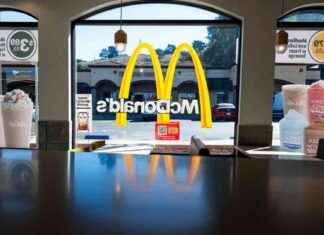In this upcoming book, Jackson is a serious fellow and helps his new stepsister, Sophie, at their parents’ wedding.Floyd Cooper
It takes a very special children’s book to make me mist up, especially during a happy moment.
In Floyd Cooper’s “The Ring Bearer” (Penguin for Young Readers, $16.99), which comes out in April, Jackson’s mom is getting married. A deliberate child, he worries about his big job as ring bearer.
Jackson watches his new little stepsister, Sophie, skip down the aisle, strewing petals. Just as she’s about to trip, he catches her. It’s a moment that shows Jackson he will be a good brother and the one that did me in because I am a sucker for kind siblings and beautiful art.
Cooper, whose illustrated books number 100 – if you ask him; 85 according to his wife – has also written the last six. He teaches gently. In his book about Michael Jordan, the lesson wasn’t that he was merely one of the greatest basketball players but someone who combined talent, persistence and discipline.
Cooper, 61, lived in West Orange for a third of his life. He’s won the Coretta Scott King Award and lectures at schools. Cooper spoke with New Jersey Authors and what follows is an edited version of that interview.
Floyd Cooper, who lived in West Orange for over 20 years, has illustrated about 100 books and written six, including a biography of Michael Jordan.Jacob Blickenstaff
Were you always an artist?
I scribbled on the side of our house outside. Dad was building the house, where we lived in Oklahoma. There was sheetrock and I just picked it up and started scratching away. My mom — we did drills every evening on lined paper — and so I began to express myself that way. My path was set from that early age. And I got a scholarship to the University of Oklahoma based on my art.
Did you do other related work before the books?
I went against my professors’ wishes and went to work for the dreaded Hallmark for two years.
What were you drawing there?
I got into revamp and we would take products that Hallmark kept in vaults and update them. We were just were erasing someone’s artwork and making better. It was free art supplies and I made my connections and came to New York in 1984.
What was your first book and what did you learn doing it?
“Grandpa’s Face” by Eloise Greenfield. I did it very, very quickly and it comes back with my name on it and it was printed forever with my mistakes.
The painter and writer Floyd Cooper uses a few moments from a wedding to illustrate the larger meaning of coming together as a family.Floyd Cooper
How did you evolve into a writer?
My first book came because my editor Patti Gauch, who is also a writing teacher, convinced me that I could write. She showed me a way of writing that paralleled a way I illustrate and I developed a formula for writing visual metaphor.
Your theory about art involves erasing, with writing does that mean deleting?
It’s subtractive. I use an eraser to erase shapes from a background. I brush it on with a big 1-inch trim brush with very thin oil paint. It dries and I start erasing shapes into the background. I learned that technique when at Hallmark.
I began to see writing the same way of seeing someone’s life and I would tie their life events to a metaphor. For Langston Hughes the metaphor was the wind and it developed a rhythmic quality to the words. This wind that constantly pulled through his life.
So when you start painting, you have the story?
Yes, I have the story written and I try to keep it as simple as possible. I keep cutting the text and let the pictures show rather than say it.
Who are your favorite writers?
Joyce Carol Thomas, Virginia Hamilton, Jerry Pinkney and Paul O. Zelinsky.
Where did you get your first library card?
Tulsa, Oklahoma. I remember the little drawers you pulled out, the Dewey Decimal system.
Given the racial strife in the country, are your books, featuring African-American children, more important now?
I’m gonna say yes; I felt that was where I could contribute. I met Augusta Baker a famed librarian from the New York Public Library in the 30s and 40s. She told me her life had been devoted to putting a book about a little black child into the hands of a little white child and a book about a little white child into the hands of a little black child. On my way home I realized we gravitate to books about ourselves and when we venture out to pick up a book about others, it opens up a door that brings us into a whole new place, and it is a place we need to be and learn more about each other and who we share this planet with.
Our editors found this article on this site using Google and regenerated it for our readers.





